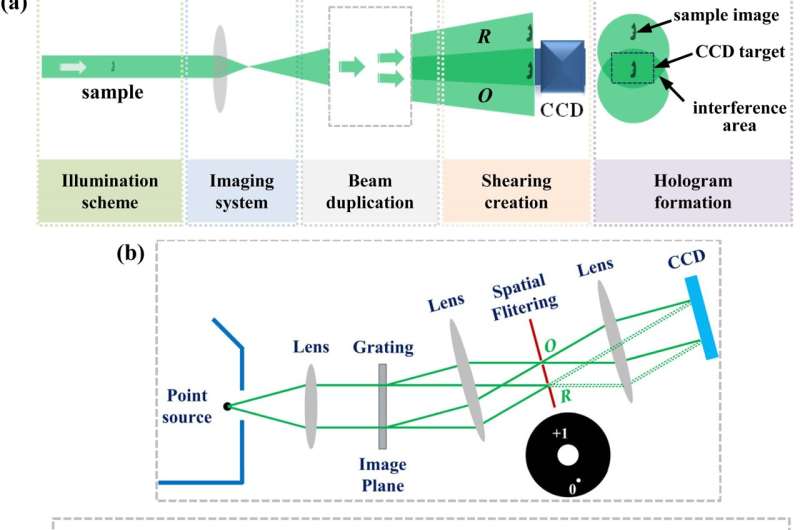Common-path off-axis digital holography: Towards high stable optical instrument manufacturing

High stable common-path digital holographic interferometers can be widely applied in long-term time-lapsing interferometric measurements, three-dimensional imaging, and quantitative phase imaging. Scientists in China reviewed the common-path off-axis digital holography and categorized the common-path models into lateral shearing, point diffraction and other types, and summarized the progress of this topic in detail. Benefiting from compact features, common-path digital holography is very promising for the manufacture of highly-stable optical measurement and imaging instruments in the future.
Digital holography possesses the advantages of wide-field, non-contact, precise, and dynamic measurements for the complex amplitude of object waves. Today, digital holography and its derivatives have been widely applied in interferometric measurements, three-dimensional imaging, and quantitative phase imaging. However, in conventional off-axis holographic experimental setups, the object and reference beams propagate in separated paths, resulting in low temporal stability. By designing common-path configurations where the two interference beams share the same or similar paths, environmental disturbance to the two beams can be effectively compensated. Therefore, the temporal stability of the experimental setups for hologram recording can be significantly improved for long-term time-lapsing measurements.
In a new review paper published in Light: Advanced Manufacturing, a team of scientists, led by Professor Jianlin Zhao from Key Laboratory of Light Field Manipulation and Information Acquisition, Ministry of Industry and Information Technology, and Shaanxi Key Laboratory of Optical Information Technology, School of Physical Science and Technology, Northwestern Polytechnical University, China, and co-workers have reviewed the configuration designs of common-path off-axis digital holography and categorized the common-path models as lateral shearing, point diffraction, and other types based on the different approaches to generate the reference beam. They summarized the design principles and application scenarios of different types. In addition, the commercial manufacturing of common-path digital holographic interferometers has been prospected.
"To record an off-axis hologram, the object beam must interfere with a uniform reference beam at a certain angle. The key issue to design a common-path configuration is to generate a uniform reference beam allowing the two interference beams to pass along similar paths. The greater the level of similarity, the greater the stability of the optical setup." the authors summarized.
"As for the lateral shearing-based type, the beam carrying the object information is first doubled using a certain optical component, like, a glass plate, grating, or beam splitter. Then, the portions of the two beams with and without the sample information create the shearing interference. This type has a simpler and more compact design. However, it requires an undisturbed portion of the illumination beam to generate the reference beam, which could reduce the field of view. This type is typically applied to spatially sparse samples."
"Conversely, the point diffraction-based type creates a uniform reference beam from the object beam by low-pass filtering in the Fourier domain. This type does not have the problem of limited field of view. However, it typically has a complex configuration. This type is suitable for measuring microscopic samples with high spatial frequency, as it is easy to generate the uniform reference beam by spatial filtering. The third type has advanced designs such as using folding mirrors, specially-positioned beam splitter cubes, and Wollaston prisms. These designs could avoid the disadvantages existing in the former two types." the scientists forecast.
More information: Jiwei Zhang et al, A review of common-path off-axis digital holography: towards high stable optical instrument manufacturing, Light: Advanced Manufacturing (2021). DOI: 10.37188/lam.2021.023
Provided by Chinese Academy of Sciences





















